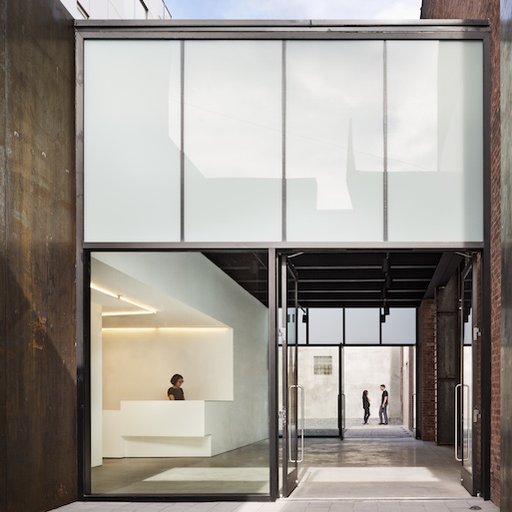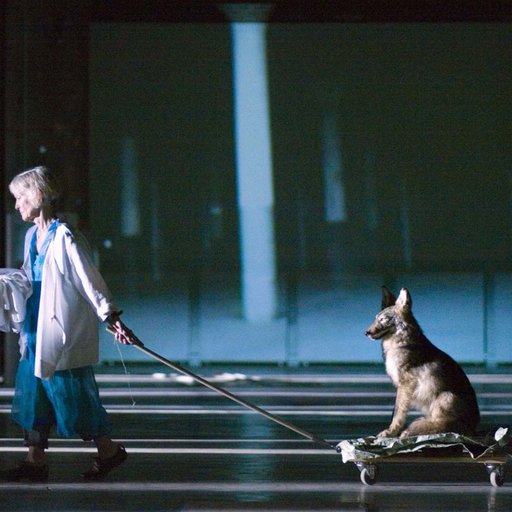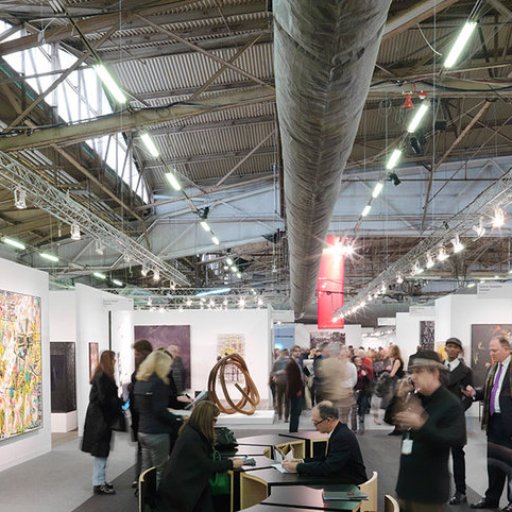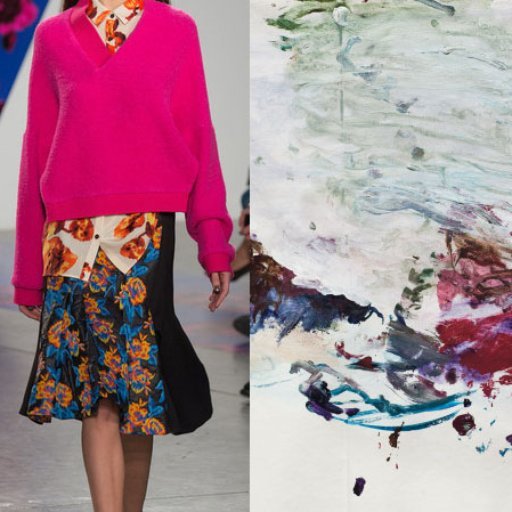This week there was an unusually lively art talk at the New York Public Library. It was between Massimiliano Gioni, the visionary New Museum curator behind the last Venice Biennale, and Jeffrey Deitch, who ring-led the downtown New York art scene with his carnivalesque Deitch Projects gallery before going off to try his hand at directing MOCA—an expedition as disastrous and empire-ending as Alcibiades’s Sicilian expedition, for those who recall the Peloponnesian war. The two men are close friends—both, oddly, are former U.S. editors for Flash Art magazine, and both work with the Greek collector Dakis Joannou—and they had a lot to talk about.
Gioni turns out to make an excellent interviewer. Here are a few of the more fascinating tidbits about Deitch to emerge from the hour-and-a-half conversation, in the dealer's words.
1. WHICH GALLERIES INSPIRED DEITCH PROJECTS?
Geert van Beijeren & Adriaan van Ravesteijn’s Art & Project gallery in Amsterdam and Stuart and Shaun Regen’s Regen Projects in Los Angeles
2. WHAT ELSE INSPIRED HIM?
“The history of discotechs and clubs in New York in the mid ’70s. There are a number of important formal innovations in these discos and clubs. One of them was the dissolving of the barrier between the performer and the participants. Everybody was a part of it—you didn’t go to a disco to just stand and look at the DJ, you were a part of it and the DJ responded to you. You had a kind of similar connection with the audience and the performer at punk clubs like CBGB, with people running up onstage and tackling the performers, or the performers jumping into the audience. I’m very interested and this is a whole aesthetic trend and the innovation of this erosion of the barrier between the auteur and the audience.”
3. DOES NICENESS COME FIRST OR SECOND?
“Coagula, a vicious rag,… gave us an award our first year as having the best atmosphere of any gallery. So that was very important to us that people at the front desk actually made eye contact, they would say hello and pull up a chair.”
4. HOW DID NO ONE DIE DURING THE MAKING OF DAN COLEN AND DASH SNOW'S “NEST”?
“Our gallery wasn’t that big but it still took a lot of phone books. First we ordered several thousand phone books and we got connected with students at Pratt Institute. We got about 20 Pratt Institute students to sit around all night shredding up phone books. We supplied pizza to keep them going. This went on for about a week and we just had a little pile. It took a lot, because Dan was insisting that it had to be hand shredded. ‘You can’t do it with a machine, it’s not the same quality.’ Finally he gave up and we got one of these gigantic shredding trucks that pulled up in front of the gallery and we ordered another 10,000 phone books. We put them all through and we had the most beautiful hamster’s nest, which of course the artists proceeded to totally trash.
"I had to be very careful though. We set these up with monitors, and our most trusted art handlers were there to stay up all night and not drink anything to make sure that nothing happens. Two of our staff… I don’t know if they were the most trustworthy, but they were the ones that wanted to stay up all night. And I said, ‘Make sure you stay cool.’ And of course they all ended up participating. It’s a miracle that nothing bad happened because later I saw photographs of Dash—to whom I had said, ‘Please, ensure me you’re not going to smoke inside there”—in triumph as he finished. He took an acetylene torch and lit it, like the Statue of Liberty, in the center of the hamster’s nest.”
5. WHAT IS ONE OF THE “MONSTERS” THAT HE GAVE BIRTH TO?
“This interesting intersection that we all know about of fashion, music, art, film becoming closer and closer, with the borders being blurred between these different media.”
6. WHAT IS THE FIRST “MONSTER” HE CREATED?
“Well, the first monster that I created was the invention of the professional art advisor. Back in 1979, I went to Chase Manhattan Bank and Citibank with a proposition that they should start an art market department that would advise clients collecting art, advise estates that inherited art, and lend money against art for collectors, artists, and dealers. At the time, when there was high inflation and the stock market had been stagnant in the ‘70s. Both banks were very interested, and both said we want to do this. And I decided to go with Citibank, which was the more dynamic bank in the ‘70s, and I spent a decade building international art advisor departments. For me personally, it was a framework for me to learn connoisseurship, which is very difficult to do…. After seeing thousands of works of art and understanding why one work sells for $100,000 in an auction and then another one that seems to look just as good sells for $200,000 is how I learned connoisseurship. ”
7. WHAT IS THE KIND OF THING THAT PEOPLE TALKED ABOUT IN NEW YORK?
Oleg Kulik, “like many artists, was inspired by the great Joseph Beuys performance in New York at René Block’s gallery in 1974: I Like America and America Likes Me. It was during the Vietnam War and Beuys determined that he was not going to set foot on American soil in protest. So he brought in an ambulance from the airport to the René Block gallery and never set walked on the streets. So Oleg Kulik had a very clever idea. He called his performance, I Bite America and America Bites Me. We picked him up at JFK, and he was already in character as a dog. He crawled out of the terminal, he crawled to the parking lot, crawled into the back of the station wagon that we had rented. Sarah Watson, who was our director at the time, was in the car with me, and she turned around and was terrified to see that he was already in his role.
"We realized that we were onto something that we weren’t going to be able to control. We built the perfect cell to his specifications and we had animal trainers come in those outfits with the kind of sleeves where if a dog bites you’re ok. Kulik was a brilliant performer. He was so convincing that you really thought there was a dog in there, not a man. Naked the whole time, he stayed in character. One night I sneaked in and he was still there, naked with his wife, with a bowl of gruel that she had made for him. This is the kind of thing in New York that people talked about.”
8. WHAT WAS THE BUSINESS MODEL OF DEITCH PROJECTS?
“We set a whole system: each artist who was invited was offered, if they needed it, up to $25,000 as a production budget. It was very generous for that time…. The deal was that we would provide that funding, give the artist studio space, assistants, materials, and put on the project, and, if we sold it, the money would be reimbursed and the gallery and the artist would split 50/50. If we didn’t sell it, I would just keep the project and add it to my collection. But what happened from the beginning, we actually sold these crazy projects.”
9. WHAT WAS HIS VACATION SCHEDULE WITH LEGENDARY MOMA PAINTINGS & SCULPTURE CURATOR WILLIAM RUBIN?
“I spent a week or so with him at his house in the South of France with this insanely rigorous schedule of: 8 a.m. to 8:15 listen to music, 8:15 to 8:30 have a cup of coffee and talk, and then you have to be quiet and listen to more music. It went on like this the whole day, this rigorous schedule.”
10. WHAT’S WITH THE SUIT?
“I was introduced to a very good tailor in Rome back in the ‘80s—it’s one of my indulgences. Despite the suit, I think you would agree that my outlook in art is more radical and more transgressive than almost any institutional curator.”
11. WHEN HE STARTED OUT AS AN ARTIST, WHAT KIND OF ART DID HE DO?
He was a performance artist whose work consisted of “starting up fights in the street.”
12. WHAT DID HE READ GROWING UP?
“When I was in school in Connecticut I had two bibles. One was Avalanche magazine… the other was Interview magazine, I read every single word of Interview magazine, every issue…. [Warhol Museum director] Eric Shiner found in one of Andy’s time capsules that I had written a letter to Andy to ask if I could be a summer intern working with him. It was a very funny letter. Andy never answered it, he just threw it in the time capsule box. But, of course I eventually got to meet Andy and work with him. One of the most interesting projects I did early on was to bring Andy to Hong Kong and then to China…. Andy’s made such an impact on artists there, it’s referred to all the time.”
13. HOW BAD DID IT GET WHEN HE WAS SINGLEHANDEDLY FUNDING THE FABRICATION OF JEFF KOONS’S “CELEBRATION SERIES”?
“It got to such a point that the banks took away Jeff’s credit cards. He couldn’t even travel. He hit rock bottom, and he was basically bringing me down with him. At one point there was $11 million in commitments I had to Jeff’s celebration project. For me, people sometimes say this must have been so horrible. This is, for me, what it’s all about. It’s going all the way to get behind something that you believe in. In retrospect, it was very exciting….Through it all, he was still making what I believe is the most significant body of artwork by any artist of my generation. And that’s where I wanted to be—I wanted to be behind it.”
14. HOW DOESN’T HE LOOK AT ART?
“There was a two-day symposium that the Whitney put on during the Jeff Koons show. One after another, the speakers were talking about criticality. That that was the essential ingredient of art: criticality. ‘Is there enough criticality in the work?’ And they sort of got to the early work with the vacuum cleaners: ‘Yes, that had some criticality.’ But then they stopped when it started getting shiny. It’s interesting for me—is criticality what art is essentially about? There’s so many other aspects to art that are very important: about creating resonant imagery, about jogging your emotions in a very profound way, and we can go on and on. That academic frame of expecting that unless it’s critical, unless it’s anti-capitalist or something, then it’s not valid as art—that’s not how I look at art.”
15. WHAT’S THAT MICHAEL JACKSON STORY AGAIN?
“When I was working on the art advising business at CitiBank, there was a retired museum director who had been given one of his former trustee’s client’s Trump Tower apartment to use when he came to New York to show works of art. I went up there and said, ‘This is pretty good!’ It was much better than going up those elevators in one of those 57th street buildings between 5th and 6th…. So when I started my own business, one longtime clients and friend… had a small apartment in Trump Tower that he wasn’t using and I said to him, ‘How about a barter deal? Art advisory services in exchange for using your apartment?’ And he said, ‘Of course, why not? You’re welcome!’ That’s one of the ways that I started my business with no money.
“I ended up in the Trump Tower. I had a big apartment there, and it was a fascinating club in there. Almost nobody actually lives there—it’s just people who uses it as a pied-à-terre. So with the people who were actually there, you got to know them. At one point, Michael Jackson was making an album in New York and he spent six months in a Trump Tower apartment, and it was amazing to see him come in. He worked very hard, so late at night he would come from the studio with a hat and a mask covering his face. We heard these stories in the morning that he would order the same coffee from the deli on Lexington avenue as the doorman and they wouldn’t see him, they would just ring the bell with this little paper bag of coffee and he would extend his hand, they would put the paper bag in it, and he would withdraw the hand.
“I was so intrigued that he actually lived there, so I had bribed one of the doorman and I said, ‘When you access the apartment, could you leave this Jeff Koons catalogue with Michael Jackson and Bubbles on the cover, with this note from me?’ He said, ‘Well, okay, I’ll do it.’ The note basically said to Michael, ‘We would like to sell to you this sculpture of you.’ …. I heard from Michael years later when he got interested in the work of Kehinde Wiley… [who] painted this spectacular portrait of Michael Jackson on a horse, it’s in the Brooklyn Museum now. We were actually able to arrange this conversation between Michael and Kehinde. Kehinde claims to have it on tape, but he’s discreet about it. He couldn’t believe Michael’s knowledge on Old Master painting and art history. But he didn’t end up buying that one either.”
16. WHAT’S HIS FAVORITE ART BOOK?
“My favorite art book is New York: The New Art Scene [1967], with photographs by Ugo Mulas and text by Alan Solomon.”
17. HOW DID HE COIN THE TERM “POST-HUMAN”?
“I came up with it running around the reservoir. That’s always where I get my best ideas. It’s fascinating to see how it entered the language.”
18. WHY ISN’T HE A CURATOR AT MOMA?
“Well, there was a road not taken…. In 1991, Kirk Varnedoe, who was just such a great and inspiring figure—Bill Rubin’s successor in the department of painting and sculpture at the Museum of Modern Art—offered me the job of the new position of curator of contemporary art, which didn’t exist there. The main objective was to build the collection, which really stopped at the end of the ‘60s. What an opportunity. I was thinking, ‘I’m doing really well, I just started my own art advisory business, and gotten used to….’ But I accepted it. I said, ‘Great, I want to do it. Kirk, I want to work with you.’ Bill Rubin and [the critic and curator] Robert Rosenblum were very enthusiastic, and I went through all of the interviews. It was a done deal.
“But in the art world it’s hard to keep a secret, so somehow this got out before the official announcement. One of the powerful art critics—and Kirk never told me who it was, though I have my suspicions—went to Kirk and said, very seriously, ‘If you go ahead and hire this art dealer as the curator of contemporary art, I will be relentless, I won’t stop until you yourself are forced out of your job.’ I’m all ready to start this thing, and Kirk calls me and says, ‘You have to come to my office.’ So he shares this story with me. It was very emotional. I said to Kirk—who was born for this position, he was just such a genius—‘I have some other options, don’t even worry about this, I’m withdrawing. Forget it. I don’t want to disturb your program here.’ So I withdrew.”
19. WHY DID HE GO TO MOCA?
“When Eli Broad approached me and said, ‘How would you like to be the director of MOCA?’, I just remembered this is my second chance to take the road not taken. I learned the lesson with the Museum of Modern Art situation, to keep it a secret and not to tell anybody. I only told [Gioni]. And Massimiliano warned me and said, ‘You can’t take that job.’ But I’m glad I did. Most of you know that I got beat up by the press but it was a fascinating experience. I did some great shows. I did the “Art in the Streets” show, and that was the most popular contemporary show ever in any Los Angeles museum.”
20. WHAT IS HIS ONE REGRET AT MOCA?
“My one regret is that I’m sorry that we weren’t able to present the great Björk retrospective…. Some of you may have read the diatribes against one of my favorite colleagues, Klaus Biesenbach, raging today. It reminds me of the diatribes against me when I was at MOCA. So with Klaus it’s Bjork, with me it was James Franco, unfortunately.”
21. WHAT DOES HE THINK OF MOMA, AND OF MUSEUMS GENERALLY?
“It’s not a pleasant experience to go to the Museum of Modern Art right now and see the popular shows. As most of us know, you go there and a lot of times the crowds appear to be 80 percent tourists. People where you may not be able to have an intellectual conversation with the person next to you, it’s important for them to be there—it’s a life-enhancing experience for them. But, because of these crowds, I think that, particularly for contemporary art, you need new structures and you need new buildings. You need spaces that have plenty of room for people and amenities so they can talk.
“The kind of museum architecture that the starchitects now specialize in may be obsolete, with chambers where crowds just can’t be accommodated. You may need another kind of situation where you can accommodate larger crowds and figure out how artworks can be experienced…. I think it’s time to build institutions that connect with the kind of crowd you see going to festivals like Coachella.”























